Rock Climbing at Smith Rock: All You Need to Know (2024 Guide)
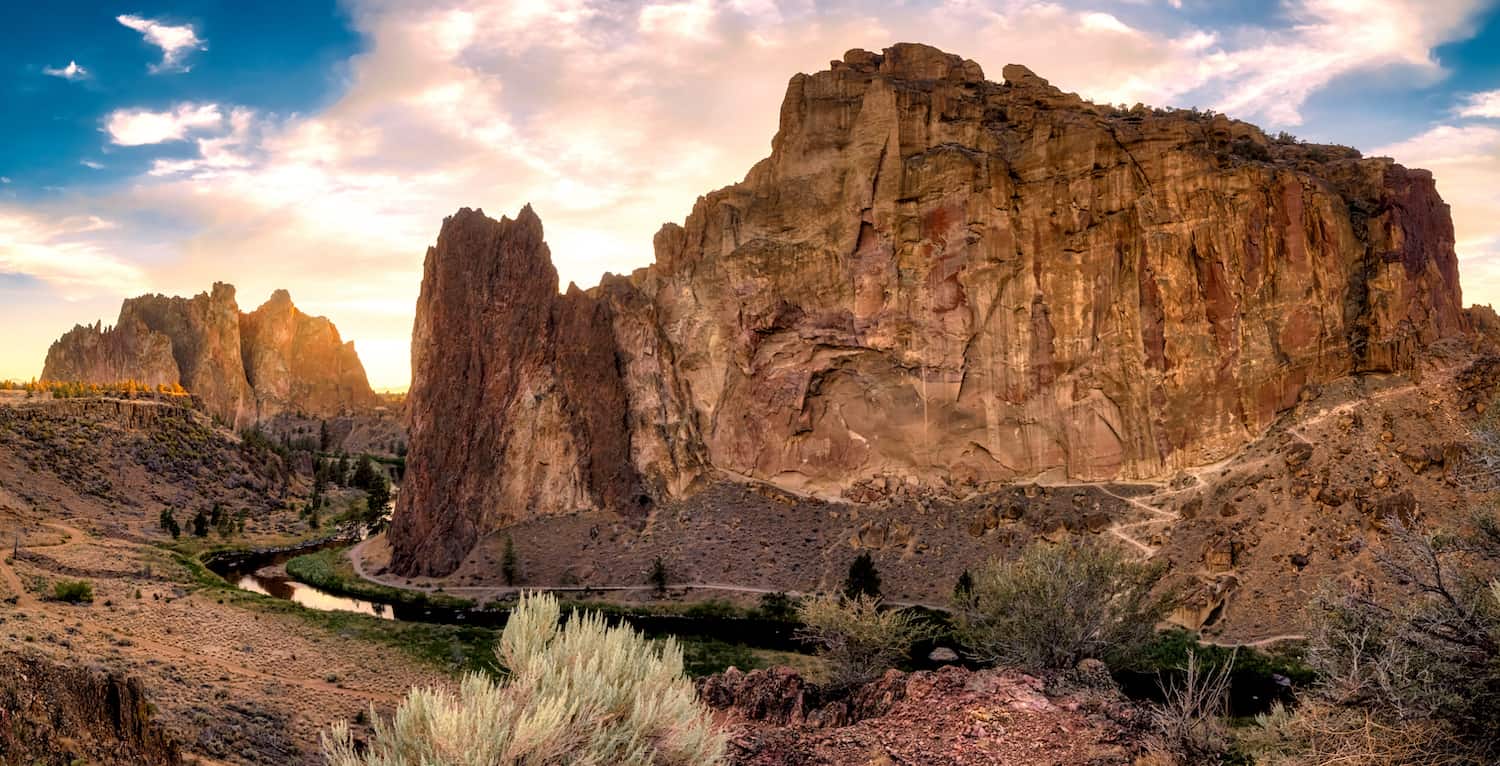
Published on: 11/05/2021
Whether you’ve just started rock climbing or are a seasoned vet, you’re almost guaranteed to know about Smith Rock State Park in Oregon. The park is home to some of North America’s best rock climbing spots. It’s especially renowned for its sport climbing routes. Smith Rock is home to some classic spots, hosting the Morning Glory Wall, Monkey Face, Picnic Lunch Wall, and Red Wall, just to name a few.
This comprehensive guide to Smith Rock gives you an outline of the park and its history in climbing, as well as climbing routes and accommodation options.
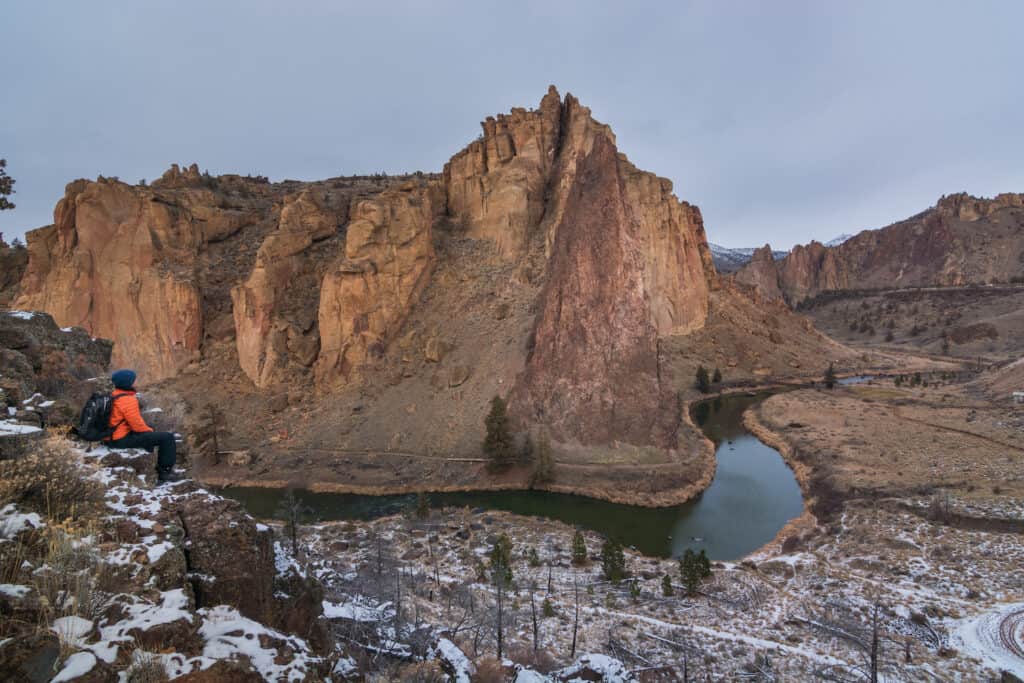
All About Smith Rock
Smith Rock State Park is one of the world’s best-known sport climbing hotspots. Located in central Oregon, Smith Park is home to over 1,800 climbing routes ranging from 5 to 11. Not only is Smith Rock State Park a sport climbing mecca, but it’s also a popular destination for hiking, mountain biking, long-distance running, and camping.
With new climbing routes put up each year, even local climbers have fresh and exciting projects to work on each season. The unusual crags and rock faces of Smith Rock are composed of volcanic welded tuff, meaning they are hardy and perfect for sport climbing.
The park is a whopping 259 hectares large and is open year-round (some routes close seasonally due to the raptor nesting season). Visitor numbers vary, but the park generally attracts 500,000+ people each year.
Practical Information – Get the Most Out of Climbing Smith Rock
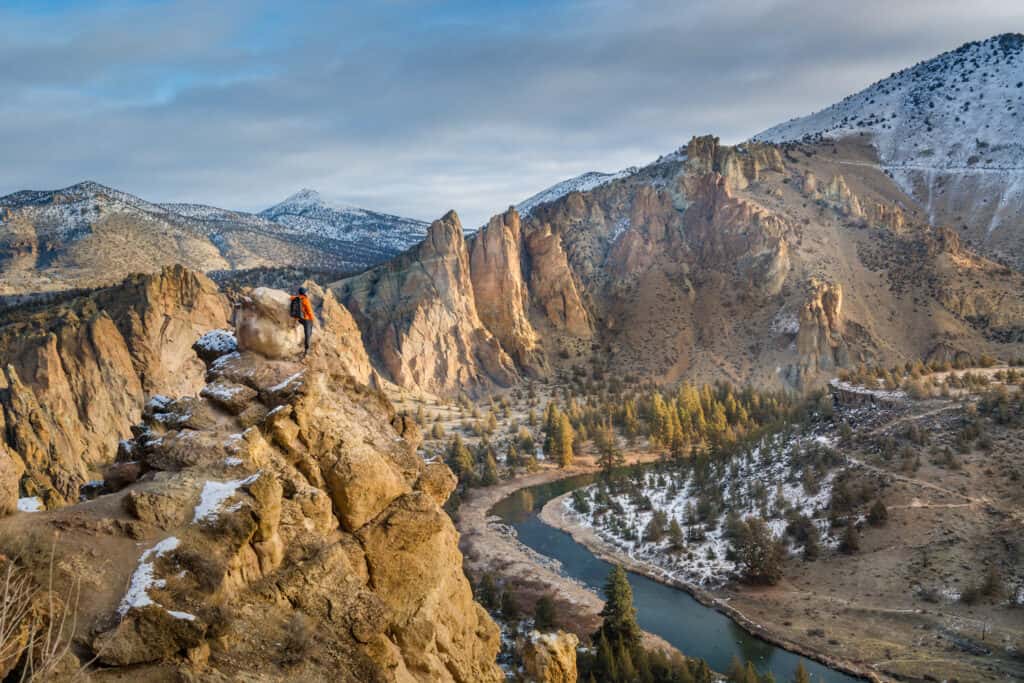
Climate and Weather Conditions at Smith Rock
Park administration at Smith Rock describes the park as having a ‘microclimate’ of its own. This means that forecasts for the wider area might not be completely reliable. Fortunately, the official park website hosts a webcam that updates every five minutes or so. If you’re planning on driving into the park from somewhere further out, checking the webcam before you depart would be wise.
Smith Rock hosts cold winters and hot summers, with winter temperatures dropping below freezing and summer temperatures occasionally reaching above 100 degrees. For this reason, the peak of the climbing season is generally mid-late spring and early autumn. These times of year will provide you with the most comfortable temperatures for climbing, but they’re also the most crowded. It is also possible to climb at the park during summer and winter, provided that you are adequately prepared for the conditions.
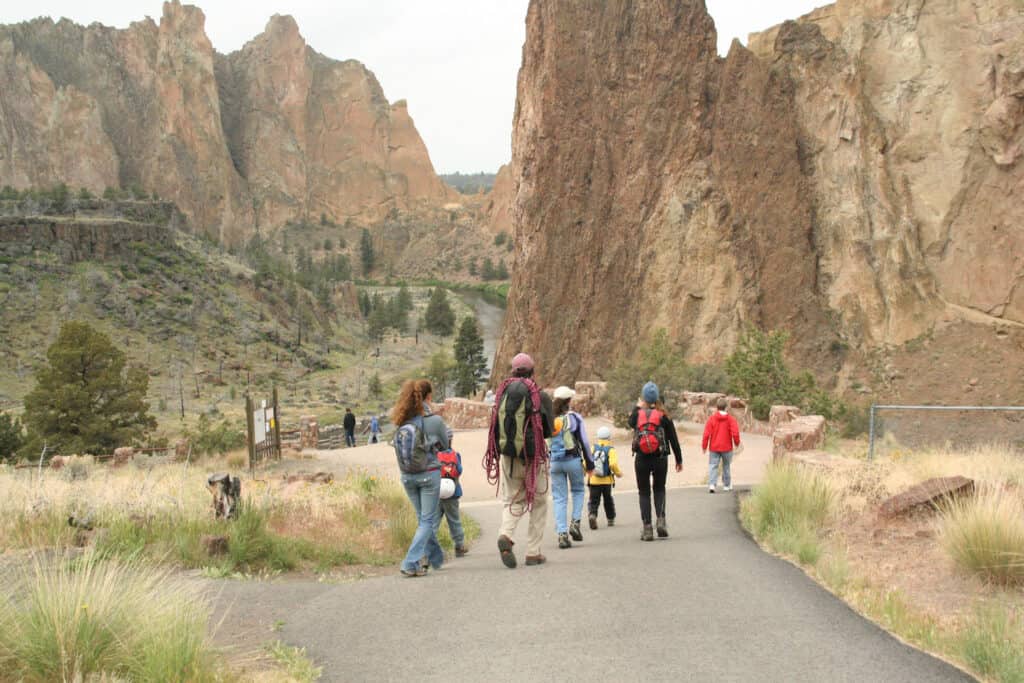
If you want to beat the crowds, then your best bet would be to visit Smith Rock out of season. During peak season, it’s not uncommon to have to wait in line for a chance at some of the more popular climbs. If you’re planning on climbing the park in summer, then it’s important to avoid climbing at the hottest time of day. Especially since temperatures can reach over 100. Bring plenty of water and try to climb in the morning or evening, when the sun isn’t at its peak.
Where to Stay
The Bivy Campground

If you’re aiming to spend as much time possible climbing in Smith Rock, then camping is probably your best bet. There’s a walk-in campground in the park grounds known as the Bivy, which operates on a first-come, first-serve basis. The campground boasts a range of amenities, including showers to those with permits, a charging station, a drinking fountain, and restrooms. Note that the fee station which sells camping permits accepts credit cards and cash, but doesn’t give change.
You’ll need to buy a camping permit for each day you stay at the Bivy; park administration sells permits each day after check-in time (4 pm). Permits cost $8 a night at the time of this article. It’s not possible to book in advance.
Other Campgrounds and RV Parks
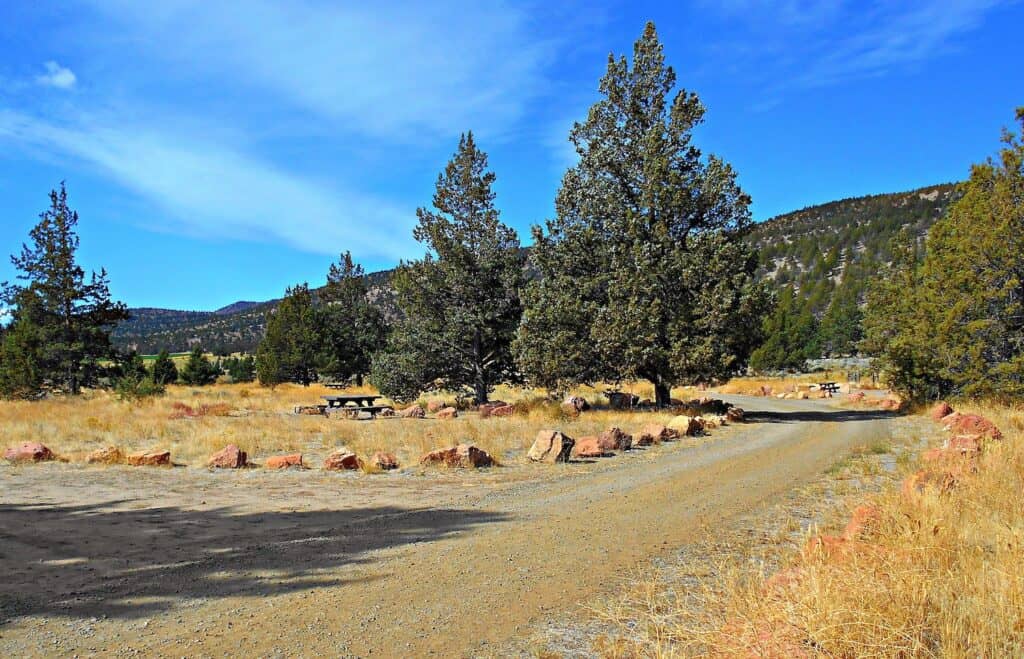
Further afield, there are several more campgrounds and RV parks to choose from, which might be a better option if you’d like to make a longer trip to Smith Rock. The closest option is the Skull Hollow campground, which is roughly 8 miles from Smith Rock. You can purchase stays of up to 14 nights at Skull Hollow, as well as park your RV there. Permits at Skull Hollow cost $10 a night. However, advance reservations are not accepted.
It’s important to note that running water is not available at Skull Hollow, so make sure to bring provisions with you. There are two pit toilets and 28 campsites available at the Skull Hollow campground. Fires are permitted at the campsite.
If you’re planning a multiple-day climbing trip, then you might want to consider staying at the Crooked River RV Park. At 20 minutes drive from Smith Rock, Crooked River has a nice range of amenities, including a swimming pool, tennis court, and golf course.
Rentals in Smith Rock, Terrebonne, and Bend

If you’d prefer to have a roof over your head during your trip to Smith Park, then you have several options available. In addition to rentals within the park grounds, you can opt to stay further afield in Terrebonne and Bend.
Smith Rock Nest
The cozy Smith Rock Nest is just a stone’s throw away from the epic crags of Smith Rock. Nestled within the park grounds, the property consists of a 3-bedroom house and is across the road from Smith Rock’s main trail. This would be a great option for families or smaller groups looking to make the absolute most of their climbing trip.
Crooked River Ranch Cabins in Terrebonne
Just outside of Terrebonne, you’ll find the Crooked River Ranch Cabins. With both cabins and chalets available and a great range of amenities, this is a good choice if you’d like to really unwind during your stay.
The Bunk + Brew Hostel in Bend
Not sold on any of the rentals near Smith Rock? If you don’t mind a bit of a drive to and from the park each day, then you might like to consider renting in Bend. One option is The Bunk + Brew, which offers guests an affordable stay in atmospheric surrounds. Located in Bend, the building itself was constructed in 1910, and some of the amenities include a fire pit, BBQ grill, and gazebo.
Park Permits
Purchasing a day permit at Smith Rock will set you back just $5. Avid climbers might like to consider purchasing a yearly permit, which costs $30. The park also offers a package of two yearly permits at a discounted rate of $50.
Invest in a Guidebook
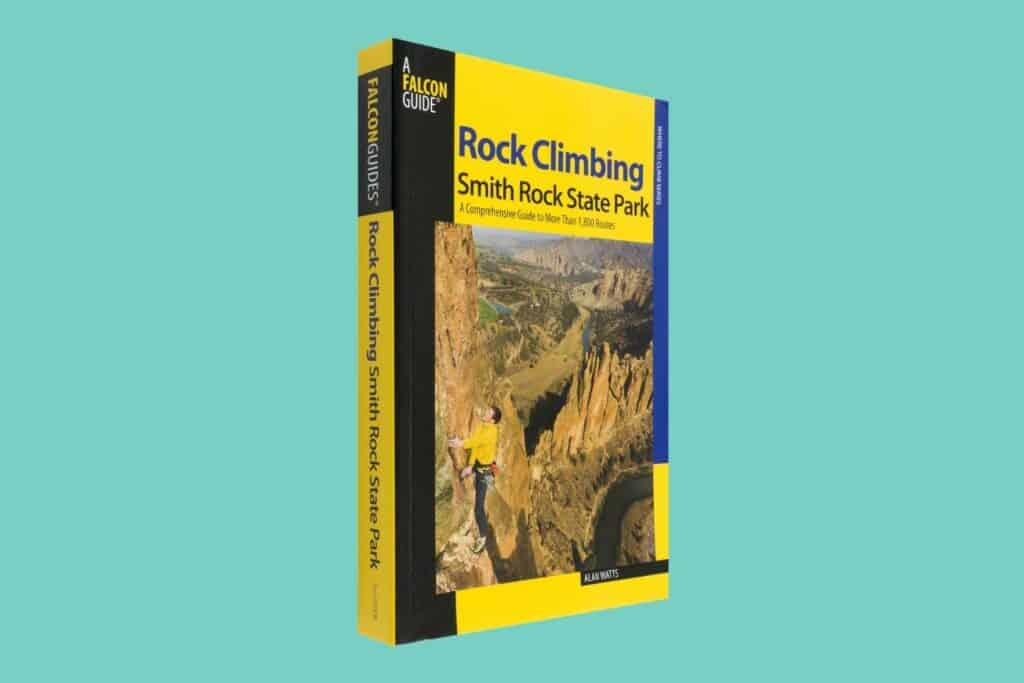
Last but not least, one of the best ways to really make the most of your time in Smith Rock is by purchasing a guidebook. Consider picking up a copy of Rock Climbing Smith Rock State Park, written by the renowned Smith Rock local Alan Watts. Watts is famous for breaking new ground in American sport climbing, much of which he did in Smith Rock. Not only did Watts himself develop some of the toughest routes in the park, but he has compiled 1,700 of them into his guidebook.
The guidebook includes pictures and a description of every route, taking the guesswork out of planning a trip to the park. While you don’t need a guidebook to enjoy your time in Smith Rock, it can really help you maximize your time there.
How to Get to Smith Rock State Park
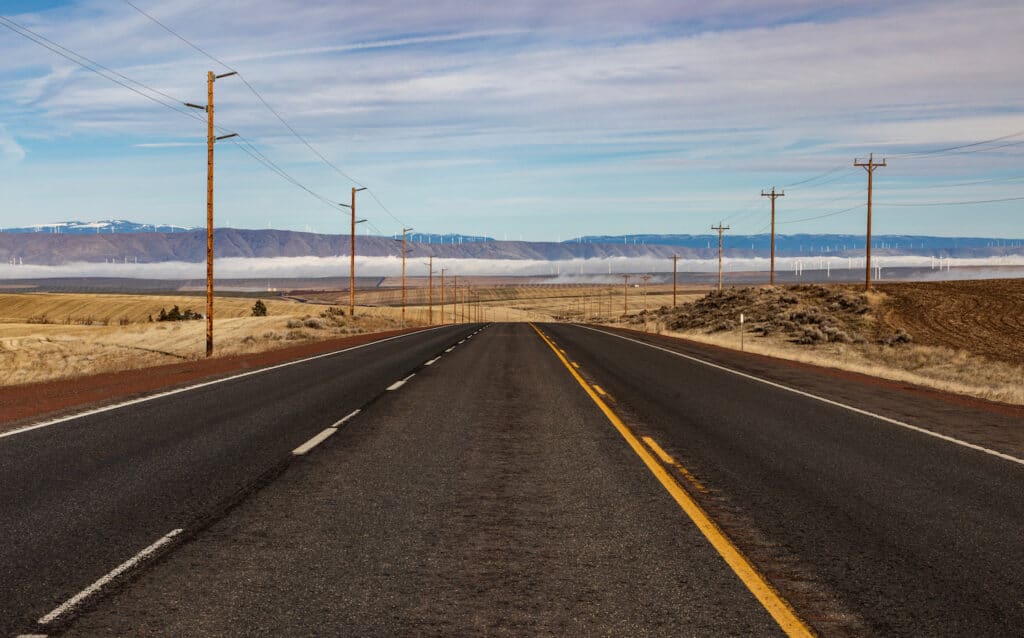
Smith Rock is part of Oregon’s High Desert and fairly remote, being found just outside the town of Terrebonne. The closest city is Bend, OR; driving to Smith Rock from Bend takes about half an hour. In addition, the park is about a 2-3 hours’ drive away from Portland. Driving to Smith Rock from the Washington State capital of Seattle is also possible within a day, taking roughly 7 hours.
Out-of-state travelers should take note that Redmond Municipal Airport is only 10 miles away from Smith Rock, and a number of airlines offer direct flights to the area. Some of the major cities served by direct flights from Redmond include Seattle, Los Angeles, Las Vegas, Denver, and Phoenix. There is no public transport to the park, but it’s possible to hire a shuttle or taxi from the airport or Bend.
When driving to the park, you will most likely approach via Terrebonne, the nearest settlement. From route 97, which runs through the center of Terrebonne, turn onto Smith Rock Way. Continue straight until you see NE 17th street approaching on your left. Take a left, and then turn right onto NE Wilcox Avenue. Your first left after this will be NE Crooked River Drive, the road that takes you directly into the park.
Alternatively, you can turn left onto Lambert Road from Smith Rock Way. Lambert Road quickly merges into NE Wilcox Avenue, so you can simply follow the road until you approach the park. You should then see NE Crooked River Drive on your left.
Our Favorite Smith Rock Climbing Routes
Smith Rock has really made its name as a destination for moderate to difficult sports climbing routes. However, with over 1,800 routes and new ones being put up every year, Smith Rock offers quality climbs for athletes at all levels of experience.
Best Routes for Beginners
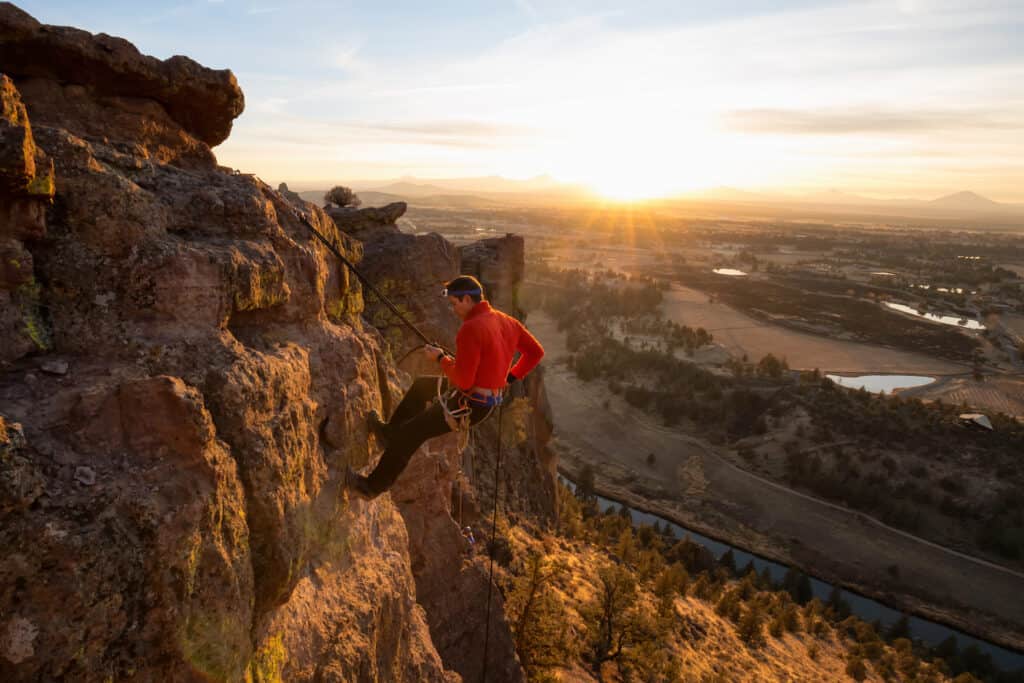
Dancer (5.7)
You’ll find the ‘Dancer’ climb in the Combination Blocks part of Smith Rock. Dancer is a fairly short and liberally bolted climb, making it a great beginner option for lead climbing. This climb is also very popular, so expect to wait in line if visiting Smith Rock during the peak season.
Hissing Llamas (5.8)
Located on the Phoenix Buttress, ‘Hissing Llamas’ starts out with a set of large jugs. As you work your way up you’ll come to a narrow seam. From there, the holds eventually get much smaller towards the crux of the route. This is another great option for beginners looking to lead climb.
Five Gallon Buckets (5.8)
One of Smith Rock’s most classic routes, Five Gallon Buckets is a route that takes you along a set of huecos in the face of the Morning Glory Wall. The popularity of the route means you might need to wait a few hours for your turn, though!
The Rope de Dope Block
The climbs found at the Rope de Dope Block are on the tougher side. Nonetheless, they are definitely doable for beginners wanting to try toprope climbing. Some of the classic routes on the block include ‘Shamu’ (5.9), ‘Mini Blender’ (5.9), ‘Low Blow’ (5.10a), and ‘Morgantown’ (5.10).
A Note on First Bolts at Smith Rock
One thing that beginner climbers should keep in mind is that many of the routes at Smith Rock have fairly high first bolts. Oftentimes, the first bolt for a given route is several feet off the ground, and many routes begin on hillsides. This can make the starting stretch of many routes tricky and somewhat treacherous, especially for beginners.
If you don’t feel 100% comfortable with this, it would be very wise to take a stick clip in with you for safety’s sake. Stick clips are often used on routes when the first bolt is especially high.
Best Routes for Intermediate Climbers

Nine Gallon Buckets (5.10c)
Like the name suggests, the ‘Nine Gallon Buckets’ is a similar route to ‘Five Gallon Buckets,’ and is also located on the Morning Glory Wall. The route starts with a set of crimps and the first bolt is fairly high up, so don’t hesitate to bring a stick clip to this one. Apart from the crux that comes midway through the route, it’s pretty much exclusively hueco climbing once you get started.
Moons of Pluto (5.10d)
While the Mesa Verde Wall is a bit of a trek from the centre of the park, it’s worth it for this climb alone. ‘Moons of Pluto’ will require you to bring your best footwork as you tackle vertical face climbing and the prominent arete. Don’t forget to enjoy the view!
Kid Packed Minivan from Hell (5.10d)
‘Kid Packed Minivan from Hell’ is another route that you’ll need to hike a fair way to get to, being located in the Mudpile. The route features jugs, huecos, nubbins, and has several cruxes, making it a fun and diverse challenge. It’s definitely off the beaten path, so doesn’t get as much traffic as many of the more popular routes in the park.
Best Routes for Advanced/Expert Climbers
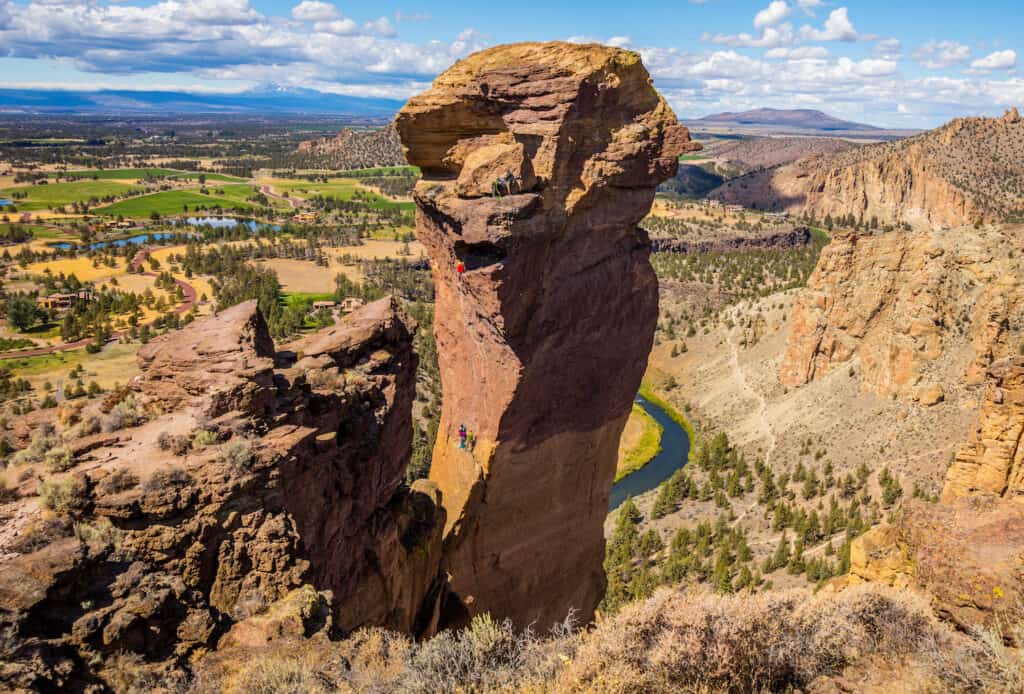
Smith Rock is home to some fantastic and exceptionally challenging climbing routes. In fact, the first route ever rated 5.14b in the USA was found in Smith Rock State Park.
Five Easy Pieces (5.13a)
Like the name alludes to, ‘Five Easy Pieces’ is a five-pitch climb that you’ll find on the Picnic Lunch Wall. It’s no walk in the park, but the rock is in great condition and the route is fairly well-protected. Note that this route is sometimes closed due to rapture nesting.
The Backbone (5.13a)
Found on the Monkey Face, ‘the Backbone’ is a versatile route with a number of variations. Combine this with the extreme exposure that much of the route subjects you to, and you have one of the most exciting routes in the park.
Dreamin’ (5.12a)
‘Dreamin” takes you up the Prophet Wall, part of the Christian Brothers rock slab. Tackle multiple cruxes as you make your way up to the slab. With clean falls and breathtaking views, this climb is not to be missed.
A Brief Guide to Trad Climbing at the Lower Gorge
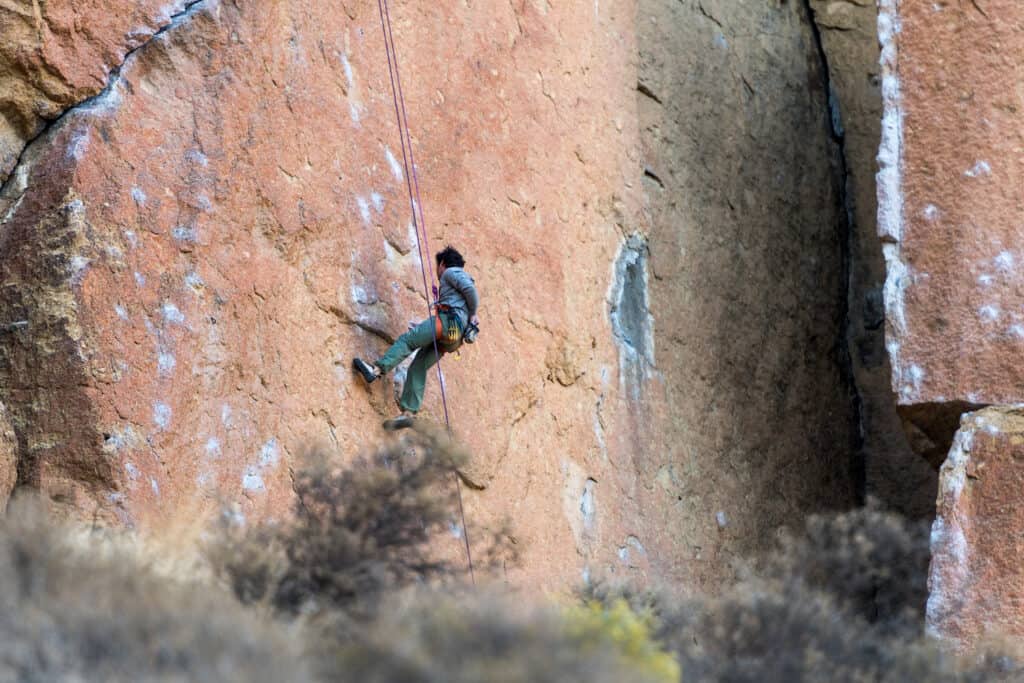
Smith Rock might be renowned for its sport climbing, but that’s far from being all the park has to offer. The Lower Gorge is found tucked away along the Crooked River and is a must-see for trad climbers. In comparison to the volcanic tuff that makes up most of Smith Rock, the gorge is home to an absurd number of basalt columns and cracks. This makes the gorge a prime spot for trad climbing in the state of Oregon. What’s more, the majority of climbers traveling to Smith Park don’t make it to the Lower Gorge.
Even during the busiest days of the year, you’ll only see a fraction of the number of people in the gorge as you will in the busiest parts of the park. Most of these will be local climbers or Smith Rock veterans. There are several approaches that you can take, depending on the time of year. Most of the routes start in the main parking lot within the park grounds.
On the History and Lore of Smith Rock – the American Sport Climbing Mecca
Smith Rock is probably one of the world’s most famous sport climbing destinations. Climbers flock to the park from all over the world to try their hand at some of the incredible routes that the area has to offer.
Some of the world’s best-known climbers have truly pushed the boundaries of the sport at Smith Rock. Alex Honnold, Adam Ondra, and Alan Watts are just a few of the athletes who have made groundbreaking new routes, onsights, and free solos in the park.
Alan Watts and Pioneering Smith Rock
Alan Watts is the man who wrote the guidebook and pioneered sports climbing in Smith Rock. A local to the area, Watts cut his teeth climbing in Smith Rock at a time when the area was virtually unknown. His achievements in climbing turned the park into a hub for elite sport climbing, attracting athletes from all over the world.
Some of the bolts that make up the different routes in Smith Park today were placed by Alan Watts himself. Watts developed some of the best-known and most difficult routes at Smith Park, including ‘To Bolt or Not to Be,’ among others. Part of Watts’ success was his choice to forego climbing norms and ethics at the peak of his career in the ’80s/’90s. Watts was more interested in pioneering a new standard of climbing. His impact on both the park and on climbing in general has been virtually peerless, and Watts still climbs Smith Rock to this day.
Adam Ondra and the ‘Forgotten Project’
In 2018, Czech climbing superstar Adam Ondra spent 6 days in Smith Rock. On the last day of his visit, he attempted to complete an old project that Alan Watts told him about, which was estimated to be a 5.14d. While fairly short, the route had a particularly awkward crux, which required transitioning from an unstable heelhook to a mono.
Ondra attempted the route several times and eventually tried to bypass the crux using a kneebar instead of heelhook to reach the mono. Unfortunately, after 8 failed attempts at the project, Ondra was ultimately unable to send the route.
Drew Ruana and ‘the Assassin’
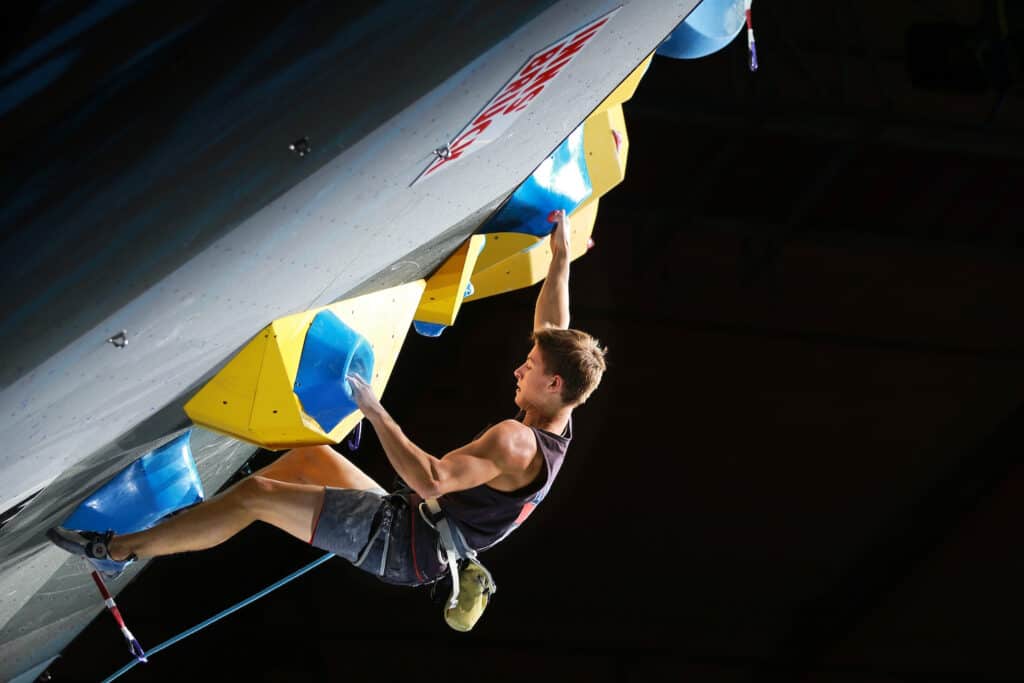
Even today, groundbreaking new routes and first ascents are being made in Smith Rock. At just 16, Ruana established and made the first ascent of ‘the Assassin’ in 2016. It’s Smith Rock’s hardest route to date. It has been rated at 5.14d and only a handful of climbers have managed to send ‘the Assassin’ since its establishment.
Looking for more? Check out The 5 Best Sport Climbing Areas in the US.

